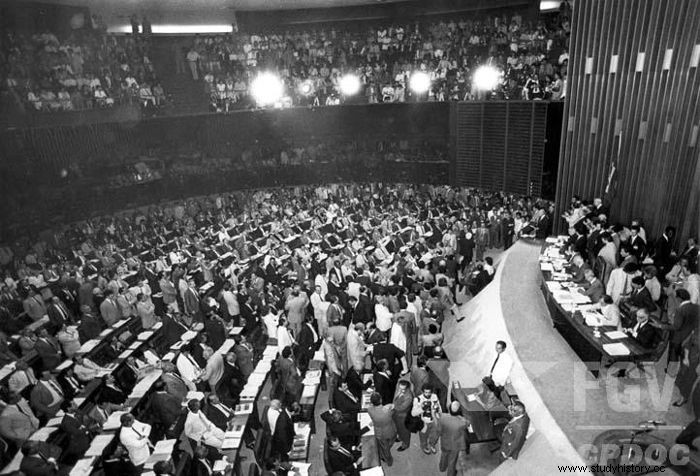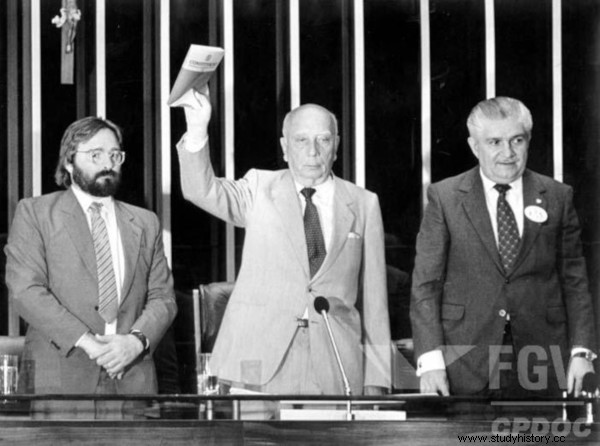
The Constitution of 1988 was written after the end of the Military Dictatorship and determined the rights and obligations of our country's citizens and political entities. Because it was created at the end of the dictatorship and because it was the result of a broad debate with the population, it became known as Citizen Constitution . It is in effect until today.
Also see: Understand how the coup that started the dictatorship in Brazil happened
Summary
The 1988 Constitution is the basic text that determines the rights and obligations of citizens and political entities in our country. It was written with the redemocratization process of Brazil, which happened after 1985, when the ticket Tancredo Snows and Joseph Sarney was elected to the Presidency of the Republic. Known as the Citizen Constitution, the 1988 Constitution was the result of a wide debate democratic, which involved several popular organizations and the engagement of millions of Brazilians.
The 1988 Constitution brought as a great advance to our country the defense of countless social rights - rights that did not exist during the Military Dictatorship -, which also includes the right of minorities , that is, groups that are historically excluded and placed on the sidelines in our society.
Evidently, the 1988 Constitution received criticism, such as the fact that it did not clearly address legislation for agrarian reform in Brazil, but its defense is of vital importance to guarantee democracy Brazilian.
Historical Background
The 1988 Constitution was the result of our country's redemocratization process and put on paper the population's aspirations for laws and rights that would protect the interests and well-being of the population. The writing of a new Constitution for Brazil was something desired by several groups in our society since the dictatorship.
In the 1970s, there were already intellectuals who debated this need. A new Constitution was a request that embraced the desires of a large part of society for a democratic government and a democratic Constitution (remembering that in that period Brazil was under the effect of the Constitution of 1967 , considered quite authoritative).
Also see: Read about the government that authorized the granting of the 1967 Constitution
The 1967 Constitution was enacted after the Institutional Act nº 4 decreed the drafting of a new Constitution for the country. The 1967 Constitution increased the powers of the Executive in relation to the Legislative and Judiciary and replaced the 1946 Constitution. An example of how there were parts of society that demanded a new Constitution can be seen when Goffredo da Silva Teles, a Brazilian jurist and university professor, read a well-known document Letter to Brazilians .
This document that demanded a new Constitution for the country was read at the USP Law School. He made a democracy defense and called for a new Constitution drawn up by a National Constituent Assembly composed of representatives chosen by the people.
The defense for the return of the Rule of Law in Brazil was finding more support in Brazilian society after years of wear and tear of military authoritarianism . This discourse was reinforced as the regime weakened and carried out actions that characterized the country's redemocratization process, such as the repeal of the AI-5 and the permission to create new parties, for example.
In 1984, the country was shaken by popular demonstrations known as Diretas Já , in which the population demanded the approval of the Constitutional Amendment Dante de Oliveira . This demonstration aimed to force parliamentarians to approve the aforementioned amendment in order to allow, in 1985, the new president of Brazil to be chosen in direct elections, and not indirect ones, as had been the case in the country since the decree of Institutional Act nº 2 .
Despite intense popular mobilization, the Diretas Já was defeated, as it did not reach the number of votes necessary for its approval (it won 298 out of 320 necessary votes). The presidential election was held indirectly and determined the election of Tancredo Neves. The Minas Gerais politician, however, did not take over for health reasons, and his deputy, José Sarney, became president of Brazil.
1987 Constituent Assembly
It was in the Sarney Government that general elections were held for governors, senators and deputies. This general election took place at the end of 1986 and was extremely important, as the elected deputies and senators would form the National Constituent Assembly that would write the new Constitution.
The elected candidates took office on February 1, 1987, and then began the work that resulted in the promulgation of the new Brazilian Constitution. The work of writing the 1988 Constitution was quite lengthy, as the text was written from scratch and numerous issues were debated and included. This happened because of the broad popular participation, which made the process of producing the 1988 Constitution very democratic. Several popular groups participated in the production and 122 popular amendments were submitted for the Constituent. These popular amendments contained the signature of more than 12 million people 1 .
The Constituent Assembly had 559 congressmen who worked directly on the composition of the new Brazilian Constitution. The mood of writing the new Constitution was to guarantee a democratic regime in Brazil that would ensure the rights and freedoms of citizens and to build democratic institutions that could sustain themselves in times of political crisis.
For one year and eight months, production efforts were carried out, which resulted in the promulgation of the Constitution on October 5, 1988 . The final text of the Constitution was presented by Ulysses Guimarães , the president of the Constituent Assembly. The 1988 Constitution is considered the ultimate symbol of the post-dictatorship period, known as the New Republic .
Achievements of the 1988 Constitution

Ulysses Guimarães, president of the Constituent Assembly, presents the Citizen Constitution in October 1988. (Credit:FGV/CPDOC)
The 1988 Constitution is considered a very advanced document, especially in matters involving the citizens' rights and on issues protecting minority rights of our country. This was only possible because of popular participation, thus expressing the population's desire to inaugurate a new phase for Brazil that was totally different from the period of the dictatorship.
Of course the 1988 Constitution is not perfect and this is made clear by historians who point out the limitations of the document on issues involving agrarian reform, for example, and the limitations of the political rights of the illiterate (who can vote, but cannot run).
The historian Boris Fausto also argues that the 1988 Constitution has limitations on the social security issue and on the issue of division of resources between the Union and states . There are also criticisms of the Constitution for being too broad and covering several issues 2 . This, however, is understood as the population's quest to have in the Constitution the guarantee of rights that were denied to them during the dictatorship.
____________________________________
1
SCHWARCZ, Lilia Moritz and STARLING, Heloísa Murgel. Brazil:A Biography. São Paulo:Companhia das Letras, 2015, p. 488.
2
FAUST, Boris. History of Brazil. São Paulo:Edusp, 2013, p. 446.
*Image credits:FGV/CPDOC
Take the opportunity to check out our video lesson on the subject:
